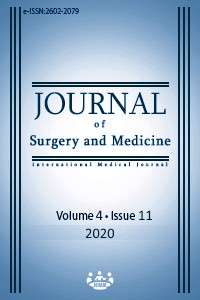Evaluation of urodynamics parameters in different age and incontinence group of women
Keywords:
Age, Stress incontinence, urge incontinance, urodynamic testAbstract
Aim: Overactive bladder syndrome (OAB) is known to have a negative impact on quality of life, and cause discomfort daily. Population-based studies on females report a prevalence of OAB which varies between 9.7% and 35.7%, with a substantial rise with increasing age. The primary aim of this analysis was to assess whether age was associated with differences in urodynamic testing parameters, using age as a continuous variable, and comparing women within wider age groups to understand physiologic variation. Methods: In this retrospective cohort study, we evaluated the patients who were admitted to the Department of Gynecology and Obstetrics Department of Istanbul Education and Research Hospital between January 2017 and January 2020 with lower urinary tract symptoms (LUTS). Results: We found that age, first sensation and first desire to void were strongly correlated (P=0.007, P=003 respectively), but a strong desire to void and maximum cystometric capacity were not (P=0.09, P=0.11 respectively). There was a weak negative correlation between detrusor pressure (Pdet) and age (p=0.08). Histogram analysis of bladder compliance among stress, urge, mix incontinence and normal patients revealed that maximum compliance occurred in women of reproductive age. Conclusion: Aging is associated with decreased self-control, thus, increased prevalence of LUTS symptoms among older women might be more accurately considered as the loss of an adaptive threshold to urinary control rather than age-associated decline in urinary functions.
Downloads
References
Coyne KS, Wein AJ, Tubaro A, et al. The burden of lower urinary tract symptoms: evaluating the effect of LUTS on health-related quality of life, anxiety and depression: EpiLUTS. BJU Int. 2009;103(Suppl 3):4–11.
Stewart WF, Van Rooyen JB, Cundiff GW, et al. Prevalence and burden of overactive bladder in the United States. World J Urol. 2003;20:327–36.
van der Vaart CH, de Leeuw JR, Roovers JP, et al. The effect of urinary incontinence and overactive bladder symptoms on quality of life in young women. BJU Int. 2002;90(6):544–9.
Irwin DE, Milsom I, Hunskaar S, et al. Population-based survey of urinary incontinence, overactive bladder, and other lower urinary tract symptoms in five countries: results of the EPIC study. Eur Urol. 2006;50(6):1306–14.
Coyne KS, Sexton CC, Thompson CL, et al. The prevalence of lower urinary tract symptoms (LUTS) in the USA, the UK and Sweden: results from the Epidemiology of LUTS (EpiLUTS) study. BJU Int. 2009;104(3):352–60.
Jeong SJ, Kim HJ, Lee YJ, et al. Prevalence and clinical features of detrusor underactivity among elderly with lower urinary tract symptoms: a comparison between men and women. Korean J Urol. 2012;53:342–8
Stav K, Dwyer PL, Rosamilia A, Schierlitz L, Lim YN, Lee J. Midurethral sling procedures for stress urinary incontinence in women over 80 years. Neurourol Urodyn. 2010;29:1262–6.
Clarke B. The role of urodynamic assessment in the diagnosis of lower urinary tract disorders. Int Urogynecol J Pelvic Floor Dysfunct. 1997;8:196–9.
Groutz A, Gordon D, Lessing JB, Wolman I, Jaffa A, David MP. Prevalence and characteristics of voiding difficulties in women: are subjective symptoms substantiated by objective urodynamic data? Urology. 1999;54:268–72.
Hardy, CC, Keilich, SR, Harrison, AG, Knight, BE, Baker, DS, Smith, PP. The Aging Bladder Phenotype Is Not the Direct Consequence of Bladder Aging. Neurourology and Urodynamics. 2019; 38:2121-9.
Rosier, PF, Schaefer, W, Lose, G, et al. International Continence Society Good Urodynamic Practices and Terms 2016:Urodynamics, uroflowmetry, cystometry, and pressure‐flow study. Neurourology and Urodynamics. 2017;36:1243–60.
Collas D, Malone-Lee J. Age-associated changes in detrusor sensory function in women with lower urinary tract symptoms . International Urogynecology Journal. 1996;7:24–9.
Wyndaele JJ. Normality in urodynamics studied in healthy adults. J Urol. 1999; 161:899–902.
Shin YS, On JW, Kim MK. Effect of aging on urodynamic parameters in women with stress urinary incontinence. Korean J Urol. 2015 May;56(5):393-7.
Valentini FA, Robain G, Marti BG. Urodynamics in women from menopause to oldest age: what motive? What diagnosis? Int Braz J Urol. 2011;37:100–7.
Perucchini D, DeLancey JO, Ashton-Miller JA, Galecki A, Schaer GN: Age effects on urethral striated muscle. II. Anatomic location of muscle loss. Am J Obstet Gynecol. 2002;186:356-60.
Zimmern P, Litman HJ, Nager CW, Lemack GE, Richter HE, Sirls L, et al. Effect of aging on storage and voiding function in women with stress predominant urinary incontinence. J Urol 2014;192
Basu M, Postlethwaite C, Cheema K, Duckett J. The effect of age on pressure flow parameters in women with lower urinary tract symptoms. J Obstet Gynaecol 2013;33:873–6.
Pfisterer M, Griffi ths D, Rosenberg L, Schaefer W, Resnick N. The impact of detrusor overactivity on bladder function in younger and older women. Journal of Urology 2006;175:1777–83.
Kimura, Ryu et al. Age-associated urethral dysfunction in urethane-anesthetized rats. Neurourology and urodynamics. 2018;37(4):1313-9.
Yoshida M, Inadome A, Murakami S. [Pharmacological analysis of neurotransmitters contributing to lower urinary tract function]. Nihon yakurigaku zasshi. FPJ. 2003;121:307–16.
Schulze F, Maas R, Freese R, Schwedhelm E, Silberhorn E, Böger RH. Determination of a reference value for N(G), N(G)- dimethyl-L-arginine in 500 subjects. Eur J Clin Invest. 2005;35:622–6.
Rud T. Urethral pressure profile in continent women from childhood to old age. Acta Obstetricia et Gynecologica Scandinavica. 1980;59:331-5.
Sherburn M, Guthrie JR, Dudley EC, O’Connell HE, Dennerstein L. Is incontinence associated with menopause? Obstet Gynecol. 2001;98:628-33.
Downloads
- 498 1160
Published
Issue
Section
How to Cite
License
Copyright (c) 2020 Nil Atakul, Berna Şermin Kılıç
This work is licensed under a Creative Commons Attribution-NonCommercial-NoDerivatives 4.0 International License.
















